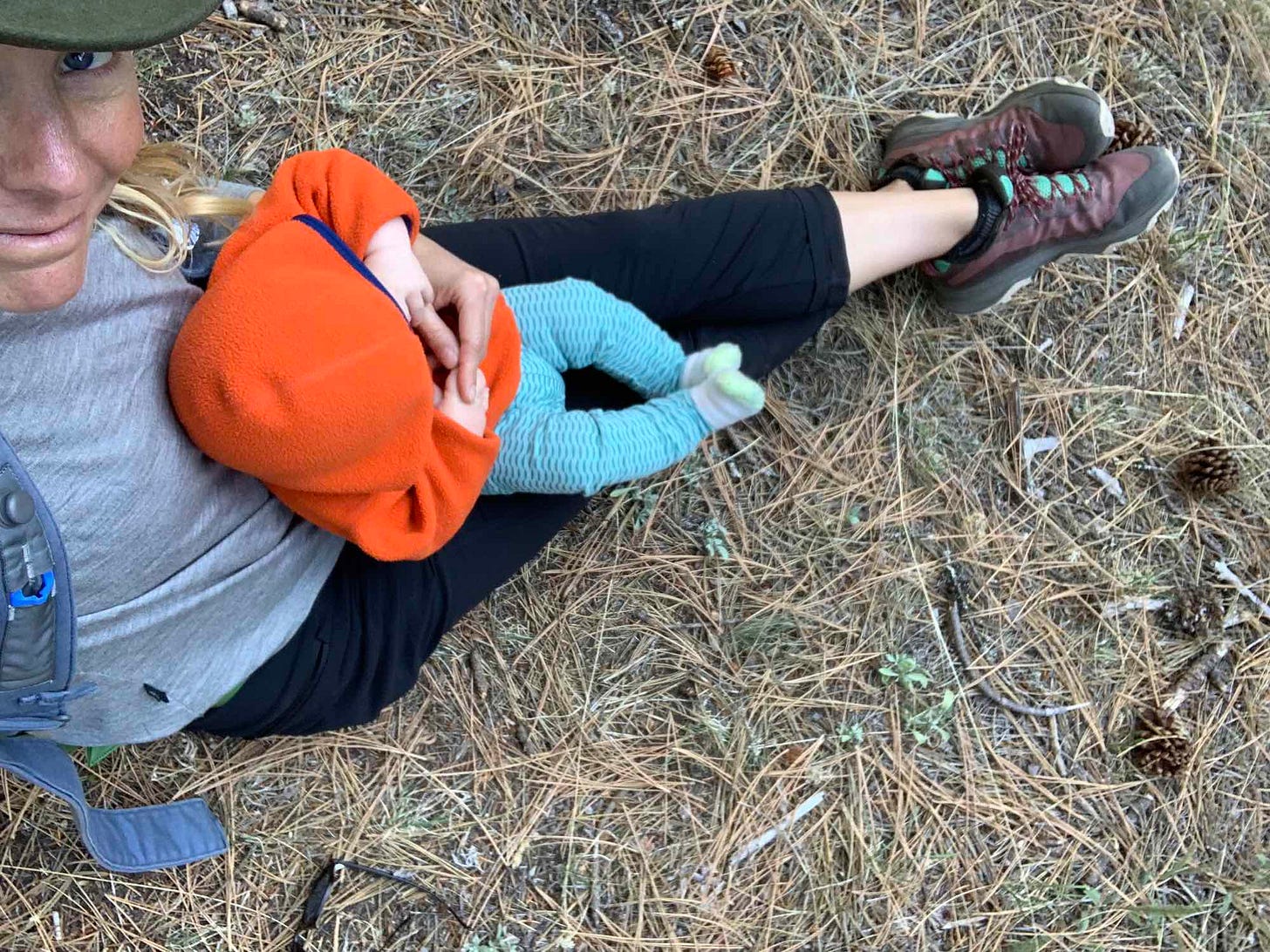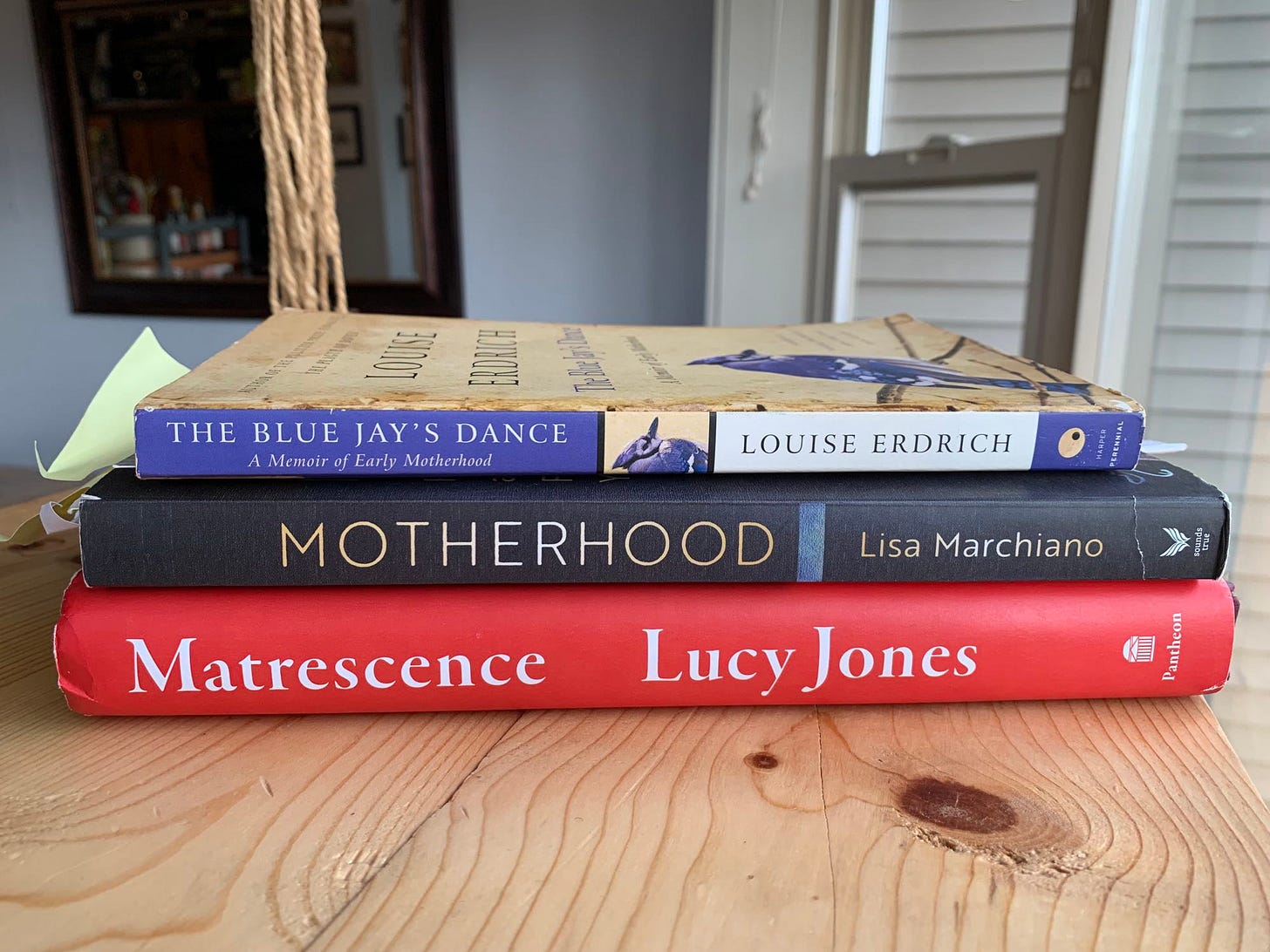The Motherhood Books I Wish I'd Read Earlier
I read a lot of books about pregnancy, childbirth and motherhood before becoming pregnant—but none of them stuck with me like these three.
For a long time I wasn’t sure whether or not I wanted to be a mom. So, reader that I am, when it came down to the wire and I needed to make a decision before it was too late, I looked for books that might help me decide. I googled books about motherhood and writing. Art and motherhood. And living child-free.
Now that I’m a mom, you know what? I don’t remember much of anything from any of them.
But, reader that I am, I kept reading. And it was only after becoming a mom that I found a few books—some quite new—that have been truly impactful, speaking authentically to my experience and shaping the way I think about motherhood. I wish I’d had these earlier, and I wonder how they could have shaped my thoughts or decisions. Would they have scared me? Reassured me? Inspired me? I think probably all three. Because the truth about motherhood is complicated—it’s hard and scary, and also intensely sweet. It’s deep in the same secret way as the dark, clear pool hidden beneath the roar of a waterfall.
In case they may be helpful to anyone out there, I thought I’d share the books that have really spoken to me, and a brief excerpt from each that has stuck with me.
Motherhood: Facing and Finding Yourself by Lisa Marchiano
This book feels like the motherhood-specific equivalent of Women Who Run With the Wolves. Marchiano is a Jungian analyst and uses the universal archetypes of fairy tales and fables to help guide readers through the journey of motherhood. If you’ve ever feared or struggled with losing yourself in parenthood, I recommend this book. I wish I’d read it years before becoming pregnant—I think it would have reassured me. Marchiano doesn’t sugarcoat how challenging motherhood will be, but she hands you tools to become a truer, better version of yourself through it.
“Motherhood, with its intense physical and emotional extremes, is a crucible in which we are tested and altered. In the alchemical vessel of motherhood, the heat is turned up high. Outdated parts of our personality are melted away, and mew structures are forged. Motherhood is a dizzying high-wire act, a masquerade, and a communion with mortality. It is a falling from and finding of grace, a falling in and out of love, and heartache by the hour. Motherhood is the ultimate confrontation with yourself. Whatever is there to discover at the bottom of your soul, whether dross or treasure, motherhood will help you find it.”
The Blue Jay’s Dance by Louise Erdrich
I think I first became aware of this book because of this piece about it in The Paris Review. After reading the library’s copy during pregnancy, I knew it was a book I needed to live on my shelf and ordered a copy for myself. It’s Erdrich’s memoir of her pregnancies and early motherhood as a writer, and the bit that lodged deep in my gut is the book’s namesake scene. At a time when so much about the world felt uncertain (it still does) and the idea of bringing a fragile new life into it felt existentially confusing and scary, this scene struck a chord. Erdrich is watching as a hawk tries to attack a blue jay.
The struck jay thrusts out its head, screams, raises its wings, and dances toward the gray hawk.
The plain of snow must seem endless, an arena without shelter, and the bird gets no help from the other six jays except loud encouragement at a safe distance. I hardly breathe. The hawk, on the ground, its wings clattering against the packed crust, is so much larger than its shadow, which has long brushed in and out of mine. It screams back, eyes filled with yellow light. Its hooked beak opens and it feints with its neck. Yet the jay, ridiculous, continues to dance, hopping forward, hornpiping up and down with tiny leaps, all of its feathers on end to increase its size. Its crest is sharp, its beak open in a continual shriek, its eye-mask fierce. It pedals its feet in the air. The hawk steps backward. She seems confused, cocks her head, and does not snap the blue jay's neck. She watches.
Although I know nothing of the hawk and cannot imagine what moves her, it does seem to me that she is fascinated, that she puzzles at the absurd display before she raises her wings and lifts off.
PAST the gray moralizing and the fierce Roman Catholic embrace of suffering and fate that so often clouds the subject of suicide, there is the blue jay's dance. Beyond the impossible corners, stark cliffs, dark wells of trapped longing, there is that manic, successful jig-cocky, exuberant, entirely a bluff, a joke. That dance makes me clench down hard on life. But it is also a dance that in other circumstances might lead me, you, anyone, to choose a voluntary death. I see in that small bird's crazy courage some of what it took for my grandparents to live out the tough times. I peer around me, stroke my own skin, look into this baby's eyes that register me as a blurred self-extension, as a function of her will. I have made a pact with life: if I were to die now it would be a form of suicide for her. Since the two of us are still in the process of differentiating, since my acts are hers and I do not even think, yet, where I stop for her or where her needs, exactly, begin, I must dance for her. I must be the one to dip and twirl in the cold glare and I must teach her, as she grows, the unlikely steps.
Matrescence: On Pregnancy, Childbirth and Motherhood by Lucy Jones
Look past the most vanilla title and nondescript cover. Inside is the most realistic, up-to-date, scientific, artistic expression of modern motherhood. It came out last year, and it’s a book I wish had existed when I was pregnant. It’s so thorough and true—from discussions of birth plans and expectations to maternity leave and unpaid labor to morphing personal identity. The concept of “matrescence” (the process of becoming a mother—said to be as enormous a shift, physically and psychologically as adolescence) seems to be having a moment right now, and none too soon in my opinion. Jones is a science writer, and she works her craft exquisitely. For real, I have 20 pages of this book dog-eared.
Each chapter is introduced by a beautiful section of prose or quotes from literature or science. (I’ve ordered multiple other books because Jones mentioned them. Ahhh the bedside stack grows.) This excerpt is longer than the others, and may feel like a tangent. But it’s possibly the bit of the book that has stuck with me the most. If you’re a mom or thinking about becoming a mom, this is for you.
Imaginal discs
When a caterpillar is ready for the next stage of its life, it finds a quiet and safe place and spins itself into a cocoon or chrysalis. Then, the caterpillar releases digestive enzymes and dissolves itself. It disintegrates into a goo. If you were to pierce its protective case, a liquid would pour out. Its metamorphosis relies on this period of being broken down and melted.
Almost. The caterpillar holds on to groups of cells called "imaginal discs." These disc-shaped structures grew when the caterpillar was still inside its egg, and there is one for each adult body part. One disc for the legs, another for the wings, one for the thorax, antennae and so on. The caterpillar sheds all that it doesn't need, leaving only these discs, which grow, powered by an amino acid-rich protein broth. It also carries previous memories into butterfly-hood or moth-hood.
A research team of biologists from Georgetown University explored the retention of memory through metamorphosis. To do this, they tested whether moths (Manduca sexta, the tobacco hornworm) could remember what they had learned when they were a caterpillar. The scientists trained a group of caterpillars to avoid the odor of ethyl acetate—a sweet and fruity smell—by using electric shocks. The caterpillars learned. After the caterpillars transformed into moths, the scientists tested the moths to see whether they would still have an aversion to the smell of ethyl acetate. They did, leading the team to conclude that memory, via intact synaptic connections, survived metamorphosis.'
For a while, the essential parts of the caterpillar are hidden within the goo— its neurons, its sensory experiences- but they do remain, and are remodeled to form the next stage of life.






Adding all three to my bedside stacks!!